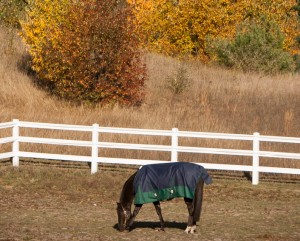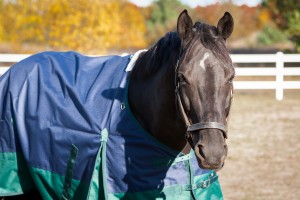There’s a nip in the air at night and blankets have been pulled from storage at horse farms, as leaves and temperatures are dropping.
So when the horses get fuzzy, and the grazing gets thin, what can we do to ensure that our favorite ones make a smooth transition into the chillier months?
In this week’s Veterinary Answers Q&A., Dr. Scott Ahlschwede, DVM, Partner at Rood & Riddle Equine Hospital of Kentucky, speaks to these issues.
Q: How does seasonal or unseasonable weather change affect the health and dietary routine of a horse?
Luckily horses are naturally well adapted to thrive in hot and cold weather.
It is the extremes in seasonal climate changes that call for the diets and environments of the horse to be managed closely to make sure his needs are met.
The most susceptible to environmental extremes are the young, old, pregnant and ill or those in pain.
Bad weather can certainly stress them enough to lead to the development other clinical health complications.
The biggest change to the dietary routine as the seasons change is the amount of available grazing.
In the winter, there is very little grass and it is cold. Roughage from grazing and hay consumption is the main source of heat production inside the animal. As pasture and temperature decrease, the demand for good quality hay goes up dramatically.
Q: Are there dietary supplements that you would recommend for aiding a horse transitioning between seasons?
The most important thing to do as we go into fall and winter, is to adjust total caloric intake as it gets colder.
Good quality hay usually provides enough boost for mature horses in good body condition.
Below 50 degrees an adult horse will need approximately two pounds of additional hay daily for every 10-degree drop in temperature. Add wind, rain, freezing temperatures and a horse’s daily needs can go from 10-15 pound to 30-40 pounds of additional hay.
For some horses that are considered to be hard keepers, some supplementations of fat maybe helpful to get their caloric intake up. Fat digestion releases minimal heat, but provides calories for energy and maintenance of body condition.
Q: There are so many products out there. What should a horse owner look for in the ingredients list to ensure that they’re giving their horse enough, without giving too much, or unnecessary additives?
The ideal situation is to feed the horse a balanced diet.
As it gets colder the demands are for more calories/energy. In feeds and supplements fats are the best way to increase energy. You want to increase energy by feeding fats and good quality hay, without increasing daily protein, vitamins, mineral or additive amounts.
Q: What other factors should be considered in preparing an equine for a healthy fall and winter?
Fall is a great time to catch up on vaccinations and de-worming.
Also look toward the top and the bottom. Good teeth ensure adequate conversion of hay to energy and heat. Well-maintained feet are critical to overall good equine health.
Remember winter is an important time to supplement your horse with salt.
A little salt will encourage a horse to drink more water, which aids in digestion and reduces the chance of gastrointestinal problems.
Keep in mind shelter and blankets are options when the weather is at its worst.





Great info and a good reminder of a horse’s needs in winter! Thanks Sue and Dr. Ahlschwede!